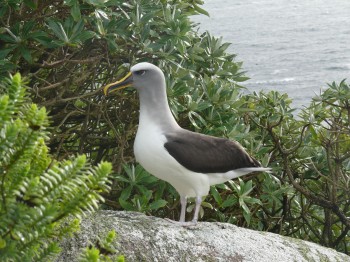Paul Sagar (National Institute of Water & Atmospheric Research, Christchurch, New Zealand) and colleagues have produced a report for the New Zealand Department of Conservation on recent research conducted on Buller’s Albatross Thalassarche bulleri at The Snares during April 2013
An abbreviated Summary follows:
“This report presents the results of demographic and tracking studies of Buller’s Albatross Thalassarche bulleri at three study colonies at The Snares during 11-29 April 2013. Demographic studies at three study colonies of Buller’s Albatross have been undertaken annually since 1992, and so this report incorporates some of these data in the current analysis. Estimates of the numbers of breeding pairs, made by recording the contents of each nest, showed substantial declines in two colonies and a slight increase in the third. A total of 353 birds banded previously as breeding adults of unknown age were recaptured within the study colonies. A further 28 breeding birds were banded in the study colonies. The oldest bird in the study colonies was banded as a breeding bird of unknown age in 1969. Assuming a minimum age of first breeding of ten years, this bird was at least 53 years old in April 2013. During the period 1992-2004 all chicks that survived to near-fledging were banded, and their survival to return to the study colonies in subsequent years has been monitored. This year 91 of these birds were captured, with birds from cohorts banded from 1999 to 2004 being recaptured for the first time, showing that long term monitoring is required to obtain reliable estimates of survival of such known-age birds. There is a strong male bias in the known-age birds recaptured, but some of this is explained by females being less likely than males to be recaptured. The average age of first breeding is 10-12 years, and recruitment to the breeding population varies widely, so further years of recapture are required before the recruitment rates of all cohorts 1992-2004 can be estimated reliably. GPS tracking of 20 birds showed that, during the guard stage, Buller’s Albatrosses foraged over the Snares Shelf and around Stewart Island and the lower South Island. Females tended to forage to the south-east and north-west whilst males foraged to the south-east and north-east of The Snares. Such differences in foraging areas between males and females was consistent with results from GPS tracking during the guard stage from 2008 to 2011.”

Buller's Albatross at The Snares, photographed by Paul Sagar
With thanks to Paul Sagar for information.
Reference:
Sagar, P., Torres, L., Thompson, D., Morrison, K. & Battley, P. 2013. Demography and tracking of Buller's Albatrosses at The Snares, and tracking of Snares Crested Penguins and Rockhopper Penguins from The Snares and Campbell Island respectively: Final research report of the 2013 field season. Prepared for Department of Conservation June 2013. Christchurch: National Institute of Water & Atmospheric Research Ltd. 18 pp.
John Cooper, ACAP Information Officer, 15 August 2013

 English
English  Français
Français  Español
Español